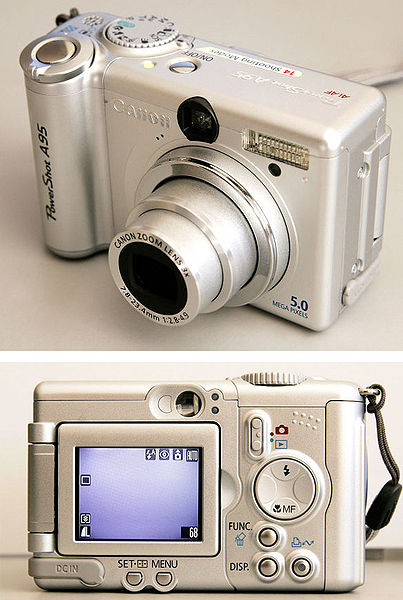Learning Resources
Digital Camera
A digital camera (or digicam) is a camera that takes video or still photographs by recording images on an electronic image sensor. Most cameras sold today are digital, and digital cameras are incorporated into many devices ranging from PDAs and mobile phones (called camera phones) to vehicles.
Digital and film cameras share an optical system, typically using a lens with a variable diaphragm to focus light onto an image pickup device. The diaphragm and shutter admit the correct amount of light to the imager, just as with film but the image pickup device is electronic rather than chemical. However, unlike film cameras, digital cameras can display images on a screen immediately after being recorded, and store and delete images from memory. Many digital cameras can also record moving video with sound. Some digital cameras can crop and stitch pictures and perform other elementary image editing.
Types
Point and Shoot Digital Camera
Just like the name implies, point and shoot digital cameras simply require that the person taking the picture point the camera at what they want to photograph and snap the photo. Point and shoot digital cameras usually have resolutions between 2 and 4 megapixels. The main functions of the camera are all automated, although some of the newer point and shoot cameras do allow the user to change and adjust settings and play around with a few limited special effects.
Point and shoot digital cameras are a great choice for the average level user who just wants to take pictures for online use, personal use or to get 4x6 photos printed. If you are looking for an entry level camera that is affordably priced and don't need a lot of fancy gizmos, a point and shoot camera might be the right option for you.
Semi-Professional Digital Cameras
Semi-professional digital cameras are quite similar in looks and style to point and shoot cameras, but have some extra features that make them more appropriate for someone who is more serious about their photography. Typically, semi-professional digital cameras have resolutions between 5 and 6 megapixels. They also offer greater control for the photographer to adjust settings and have more creative control over the final picture.
Prints made from a semi-professional digital camera are much better quality than those made from a point and shoot camera and they are usually crisp and clear up to about an 8x10" size.
If you are interested in taking higher quality photos, having more creative control over your photos, or want to take your photography to a slightly higher level, a semi-professional camera may be the right option for you.
Digital SLR Cameras
The final basic category of digital cameras is the Digital SLR. SLR is short for Single Lens Reflex, and these cameras are designed with the professional photographer in mind. Digital SLR cameras provide the greatest amount of creative control and allow you to take high quality, artistic photographs. The resolutions of SLR cameras are over 6 megapixels and can produce prints as large as poster sized without showing obvious pixels.
Many companies have started designing their digital SLR cameras to be compatible with the lenses from the older 35mm SLR cameras, which is a really nice feature that allows photographs to choose a camera that is compatible with the lenses they may already own.
Technique
Since the first digital backs were introduced, there have been three main methods of capturing the image, each based on the hardware configuration of the sensor and color filters.
The first method is often called single-shot, in reference to the number of times the camera's sensor is exposed to the light passing through the camera lens. Single-shot capture systems use either one CCD with a Bayer filter mosaic, or three separate image sensors (one each for the primary additive colors red, green, and blue) which are exposed to the same image via a beam splitter.
The second method is referred to as multi-shot because the sensor is exposed to the image in a sequence of three or more openings of the lens aperture. There are several methods of application of the multi-shot technique. The most common originally was to use a single image sensor with three filters (once again red, green and blue) passed in front of the sensor in sequence to obtain the additive color information. Another multiple shot method is called Microscanning. This technique utilizes a single CCD with a Bayer filter but actually moved the physical location of the sensor chip on the focus plane of the lens to "stitch" together a higher resolution image than the CCD would allow otherwise. A third version combined the two methods without a Bayer filter on the chip.
The third method is called scanning because the sensor moves across the focal plane much like the sensor of a desktop scanner. Their linear or tri-linear sensors utilize only a single line of photosensors, or three lines for the three colors. In some cases, scanning is accomplished by moving the sensor e.g. when using Color co-site sampling or rotate the whole camera; a digital rotating line camera offers images of very high total resolution.
The choice of method for a given capture is determined largely by the subject matter. It is usually inappropriate to attempt to capture a subject that moves with anything but a single-shot system. However, the higher color fidelity and larger file sizes and resolutions available with multi-shot and scanning backs make them attractive for commercial photographers working with stationary subjects and large-format photographs.
Dramatic improvements in single-shot cameras and raw image file processing at the beginning of the 21st century made single shot, CCD-based cameras almost completely dominant, even in high-end commercial photography. CMOS-based single shot cameras remained somewhat common.
An image of digital camera


